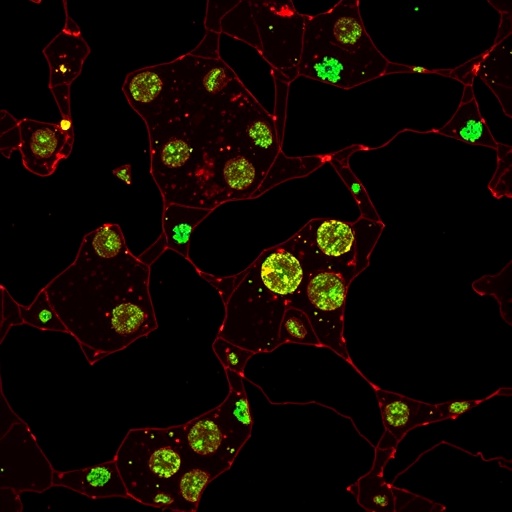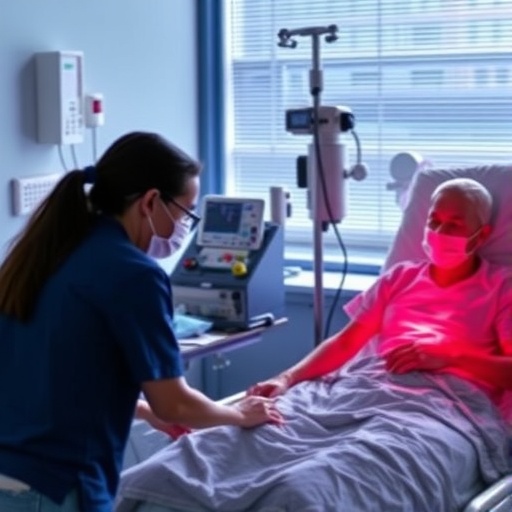Recent research has illuminated the complex interplay between cancer and the immune system, specifically in the context of gastric cancer and the mechanisms that tumors use to evade immune responses. A groundbreaking study led by Wang et al. highlights the role of TRIM32, a member of the tripartite motif family of proteins, in promoting immune evasion in gastric cancer. This study elucidates how TRIM32 contributes to the induction of immunosuppressive macrophages, which subsequently impede the effectiveness of Anti-PD-1 treatment, a popular immunotherapy strategy.
Gastric cancer, a malignancy with high mortality rates worldwide, often presents late due to nonspecific symptoms. The failure of the immune system to recognize and eliminate tumor cells is a significant challenge in treating this disease. Researchers have been investigating how tumors can manipulate the immune environment to their advantage. Wang and colleagues’ research focuses on one particular protein, TRIM32, revealing its critical role in promoting an immunosuppressive environment that not only allows tumor growth but also diminishes the efficacy of immunotherapeutic agents.
TRIM32 has been shown to be implicated in various cellular processes, including protein degradation, cell signaling, and transcriptional regulation. In the context of gastric cancer, the study found that elevated levels of TRIM32 corresponded with poor patient outcomes. By leveraging advanced mouse models and in vitro experiments, the researchers established a causal link between TRIM32 expression and the modulation of macrophages, which are crucial players in the immune response against tumors. This mechanism sheds light on why certain patients do not respond to therapies that aim to reinvigorate the immune system.
The study’s findings illustrate how TRIM32 can lead to the differentiation of macrophages into an immunosuppressive phenotype, often referred to as tumor-associated macrophages (TAMs). These TAMs contribute to creating a microenvironment conducive to tumor growth, characterized by reduced inflammation and immune cell activity. By inhibiting the function of cytotoxic T-cells, these macrophages thwart the potential of Anti-PD-1 therapies, making it increasingly difficult to mount an effective immune response against the tumor.
In analyzing further details, the researchers explored the molecular pathways involved in this process. TRIM32 was found to activate specific signaling cascades that promote the polarization of macrophages towards a subtype that secretes anti-inflammatory cytokines. This polarization is crucial, as it directly impacts the tumor’s ability to thrive and proliferate unchecked. By inhibiting pro-inflammatory signals, TRIM32 effectively suppresses the body’s natural anti-tumor immunity.
Moreover, the implications of this research extend beyond gastric cancer alone. The mechanisms discovered may be translatable to other cancer types, suggesting a broader role for TRIM32 in cancer biology. Understanding the multifaceted roles of TRIM32 could lead to new therapeutic avenues, offering potential interventions that target this protein to restore immune function. The identification of TRIM32 as a mediator of immune evasion not only enriches the existing landscape of cancer biology but also aligns with the urgent need for novel strategies to enhance the effectiveness of immunotherapies.
As the study progresses, researchers are keen to ascertain whether targeting TRIM32 might reverse the immunosuppressive actions of macrophages in not only gastric cancer but potentially other malignancies. By blocking TRIM32 or modulating its activity, there is hope that the immune system could be reactivated to combat tumors more effectively. The prospect of enhancing the efficacy of Anti-PD-1 therapies through this route is particularly exciting.
The findings of Wang et al. have sparked interest in the clinical community, as they suggest the possibility of biomarkers associated with TRIM32 that can predict patient responses to immunotherapy. This prospect emphasizes the importance of personalized medicine, where treatment strategies are tailored based on the molecular characteristics of an individual’s tumor. It might be feasible to evaluate TRIM32 expression levels as a predictive factor during treatment planning.
The implications of this research extend to clinical practices as well, indicating that molecular profiling of tumors could become routine to identify TRIM32 as a marker. Such an approach could drastically change patient management, improving outcomes by identifying those who might need alternative or additional therapeutic strategies when faced with High TRIM32 expression levels. This would enable oncologists to make informed decisions on combining therapies or choosing different treatment modalities.
Additionally, the extensive use of animal models in this study solidifies the relevance of TRIM32 in understanding immune evasion in a preclinical context. The thorough characterization of the immune landscape within tumors can serve as a blueprint for future investigations, highlighting how diverse types of immunity can be influenced by specific genetic factors in the tumor microenvironment.
As researchers build upon Wang et al.’s findings, future work may also incorporate the exploration of other immune cell types and their potential interactions with TRIM32-mediated pathways. The comprehensive study of these interactions could yield insights into a multipronged approach to treat gastric cancer and enhance the overall effectiveness of current immunotherapeutic strategies.
Taken together, the emerging narrative around TRIM32 not only illustrates the sophistication of tumor biology but also emphasizes the pressing need for continuous research in cancer immunology. By uncovering the nuanced ways in which cancers facilitate immune evasion, the scientific community moves closer to the goal of orchestrating a more robust and effective response to cancer therapies.
As the landscape of cancer treatment evolves, studies like that of Wang et al. will play a pivotal role in unveiling the molecular intricacies of tumor-immune interactions—ultimately leading to improved patient outcomes and innovative treatment strategies tailored to this debilitating disease.
As the research community grasps the importance of immune evasion in gastric cancer, the findings on TRIM32 pave the way for a deeper understanding of therapeutic resistance. By continuing to uncover the mechanisms at play, the objective remains clear: to dismantle the barriers that prevent the immune system from effectively targeting and eliminating tumors.
Through this granular understanding of tumor biology and the factors influencing immune evasion, hope remains that advancements will yield new therapeutic targets that disrupt the status quo and bring forth a new era in cancer treatment.
Subject of Research: Gastric cancer, immune evasion, TRIM32.
Article Title: TRIM32 promotes tumor immune evasion and impedes Anti–PD-1 treatment by inducing immunosuppressive macrophages in gastric cancer.
Article References:
Wang, C., Zhu, X., Wang, J. et al. TRIM32 promotes tumor immune evasion and impedes Anti–PD-1 treatment by inducing immunosuppressive macrophages in gastric cancer.
J Transl Med 23, 1187 (2025). https://doi.org/10.1186/s12967-025-06330-8
Image Credits: AI Generated
DOI: 10.1186/s12967-025-06330-8
Keywords: TRIM32, gastric cancer, immune evasion, Anti-PD-1, immunotherapy, tumor-associated macrophages, personalized medicine.
Tags: Anti-PD-1 treatment efficacyCancer immunotherapy strategiescellular processes in cancergastric cancer immune response challengesgastric cancer mortality ratesimmune evasion mechanisms in tumorsimmunosuppressive macrophages in cancerprotein degradation in tumorstranscriptional regulation in cancerTRIM32 and tumor growthTRIM32 role in gastric cancertripartite motif family proteins





